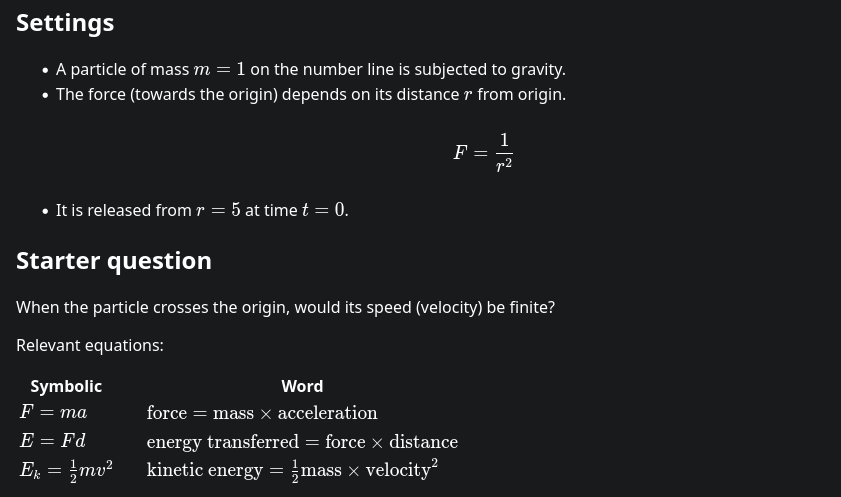this post was submitted on 17 May 2024
9 points (100.0% liked)
Daily Maths Challenges
216 readers
1 users here now
Share your cool maths problems.
Complete a challenge:
- Post your solution in comments, if it is exactly the same as OP's solution, let us know.
- Have fun.
Post a challenge:
- Doesn't have to be original, as long as it is not a duplicate.
- Challenges not riddles, if the post is longer than 3 paragraphs, reconsider yourself.
- Optionally include solution in comments, let it be clear this is not a homework help forums.
- Tag [unsolved] if you don't have a solution yet.
- Please include images, if your question includes complex symbols, attach a render of the maths.
Feel free to contribute to a series by DMing the OP, or start your own challenge series.
founded 11 months ago
MODERATORS
you are viewing a single comment's thread
view the rest of the comments
view the rest of the comments


Kind-of solution
F = ma and m = 1, so a = F = 1/r^2. I used a = -1/r^2 so the force experienced by the particle at r = 5 would be negative. a = dv/dt.dv/dt = -1/r^2
v dv/dt = -1/r^2 dr/dt → v = dr/dt. Multiply both sides by v, but write it as dr/dt on the right
v dv = -1/r^2 dr → Multiply both sides by dt
0.5v^2 = 1/r + C → Integrate
v^2 = 2/r + C → Multiply both sides by 2, find C = -2/5 by plugging in r = 5, v = 0
v^2 = 2/r - 2/5
5*arcsin(sqrt(r/5)) - sqrt(5r-r^2) = sqrt(2/5) t + C → Solve the differential equation y'^2 = 2/y - 2/5 with Wolfram Alpha, find C = 5π/2 by plugging in r = 5, t = 0
5*arcsin(sqrt(r/5)) - sqrt(5r-r^2) = sqrt(2/5) t + 5π/2 → Can find that the particle reaches the origin at t = 5sqrt(5)π / 2sqrt(2) ≈ 12.418 seconds
I made heavy use of internet resources on this one, not just for solving the differential equation but also for technique - I got a bunch of wrong answers before getting this one that I finally think is right, at least up until the moment of origin contact
Graph (the hidden ellipse is because I thought the path may be elliptical, but it doesn't appear to be)